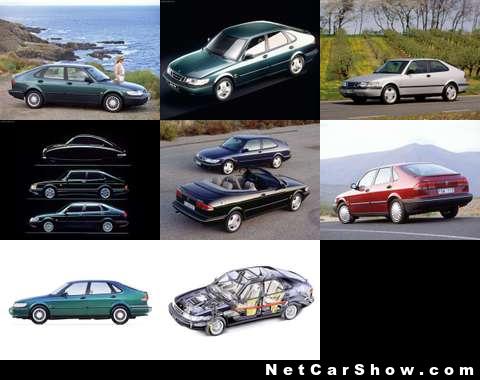Saab 900
The second generation Saab 900 (called the GM900 NG900 among enthusiasts, also sometimes written 900GM or 900NG) is a compact car / compact executive car which replaced the 'classic' Saab 900 in 1994. Influenced by General Motors, after a substantial investment in the company, the car was based on the Opel Vectra platform and its body design had design echoes from the 'classic' 900.
Variants
The cW value was improved to 0.30. Variants included the S and SE models, as well as three-door, five-door and convertible body styles. There was also a 'Talladega' version, after a record-breaking endurance test, in 1996, on the Talladega racetrack.
The new generation 900 was equipped with 2.0 L, 2.3 L, (low or full pressure turbo) Saab 16-valve DOHC engines (B202, B204, B234) and also a 2.5 L version of GM's European 54° V6 engine. Engine management was operated by Saab Direct Ignition (SDI) + Automatic Performance Control (APC) + Bosch LH Jetronic or Saab Trionic unit, although in 1996 the distributor operated ignition was re-introduced for 2.0 and 2.3 L naturally aspirated engines. The turbocharged variants powering the NG900 (B204) used Saab the Saab Trionic 5 system.
In contrast to the 'classic' Saab 900, the NG900 had a transversely-mounted engine and a rear-hinged hood (bonnet), after the style of the Saab 9000.
Night Panel
An innovation by Saab was the 'Black Panel', later to be called the 'Night Panel'. This was an aircraft-inspired system, whereby the instrument panel lights could be extinguished at night, at the touch of a button. Switch and radio lighting would also be affected but the speedometer would remain illuminated up to 85 mph. (The remainder of the speedometer would illumniate if speed exceeded 80 mph.) This allowed greater relaxation and less distraction, during night driving. Should there be a need to alert the driver's attention, at any time, the relevant instrument would become illuminated, drawing the driver's attention immediately. This system was carried over into the Saab 9-3 and the Saab 9-5.
Sensonic
There was a 'Sensonic Clutch' variant, in which no clutch pedal was required, although it had a 'manual' gear-change. This option was short-lived. The driver's hand pressure on the gear shift knob was sufficient to operate the electronically-controlled clutch.
Engines
- 2.0 L B204 full pressure 16-valve turbo intercooled, 175 hp DIN (129 kW)
- 2.0 L B204 full pressure 16-valve turbo, special with a red APC controller (see below), 185 hp 136 kW)
- 2.0 L B204 normally-aspirated 16-valve four cylinder, 133 hp
- 2.3 L B234 normally-aspirated 16-valve four cylinder, 150 hp
- 2.5 L 54° V6, 24-valve, 170 hp DIN (125 kW)
This article is licensed under the GNU Free Documentation License. It uses material from Wikipedia.







![2025 Audi S5 Sedan [US] 2025 Audi S5 Sedan [US]](/R/Audi-S5_Sedan_US-Version-2025-thb.jpg)
![2025 Audi A5 Sedan [US] 2025 Audi A5 Sedan [US]](/R/Audi-A5_Sedan_US-Version-2025-thb.jpg)
![2025 Kia EV6 GT [UK] 2025 Kia EV6 GT [UK]](/R/Kia-EV6_GT_UK-Version-2025-thb.jpg)







![Audi RS e-tron GT [UK] (2022)](/R/Audi-RS_e-tron_GT_UK-Version-2022-ec-7793b9f93574b36f0ecb6f8ca0ba72b2af.jpg)




















